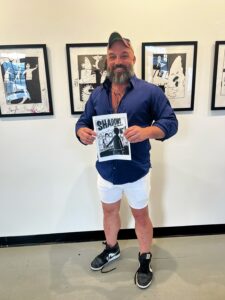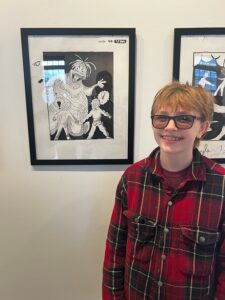PROVINCETOWN — The newest work from comic artist Phil Jimenez isn’t another issue of Spider-Man or Wonder Woman. It’s a horror story with the ominous title It Never Ends Well, and it’s a collaboration with 16 young artists from the Provincetown IB Schools’ middle-years visual arts elective.

Jimenez, who won a 2022 Eisner award for Wonder Woman Historia: The Amazons, worked with the students to create art and page layouts, giving special attention to visual storytelling and panel-by-panel continuity. The illustrations — drawn for the book by 6th-, 7th-, and 8th-grade students on official DC Comics-branded paper — are on display at the Provincetown Commons until June 9.
“Phil taught them about deadlines, getting the copy done; he taught them from start to finish how it works,” says Michael Gillane, the visual arts teacher at the school. “It gave them a taste of real life.”
The program and art show were supported by grants from both Provincetown’s and Truro’s cultural councils. When Commons Director Lesley Marchessault asked Jimenez if he would teach a class of middle-school students, he says, “I was like, ‘I love that,’ ”
Jimenez had been teaching at the School of Visual Arts in New York City for 15 years, but this was his first time working with middle-school students.
The story of It Never Ends Well, which follows four teenagers exploring a haunted hospital after their car breaks down on Route 6, was entirely the students’ invention. At first, Jimenez says, they decided to write a straightforward adventure story, but when a student suggested horror, the class erupted in cheers.
“They’d been talking about exactly the same thing in their English class, so they understood the idea of genre,” Jimenez says. “They all decided they wanted horror over adventure.”
Jimenez has plenty of experience creating horror and suspense in comic books, having drawn issues of Hellblazer, Swamp Thing, and The Invisibles for DC Comics’ mature reader-oriented Vertigo imprint during the 1990s. One Hellblazer comic, which Jimenez says is “the most horrific story I ever drew,” was a dissection of American gun politics: the issue was supposed to run in 1999, but it wasn’t published until 2010, when DC Comics published a book of previously shelved controversial material.
For Jimenez, one of the scariest things in narrative horror is pace. He taught the students how to ratchet up tension in the panels leading to a page turn. “If the final panel on a page shows a character being surprised by something, I’d ask them about the three panels that lead up to it,” he says. “That got them thinking about how to break down a story into individual narrative beats; that’s where most of the decision-making happened.”

From there, the students discussed how to foreshadow future developments: near the end of the comic, for example, one of the characters drops an inhaler; Jimenez says one of the students suggested introducing the fact that he has asthma near the beginning. “I was like, ‘Foreshadowing! This is genius!’ ” he says. “I was so excited that they understood the idea.”
Jimenez worked with the students during their 45-minute art periods every Monday, Wednesday, and Friday for about three weeks. Then, each student drew a single page of the comic.
They didn’t settle on a single drawing style. “I wanted no one to draw like anyone else,” Jimenez says. “The only rule was that the characters had to look consistent.” That meant deciding on certain traits that would remain the same no matter who was drawing. One character, for example, is recognizable by his braids; another by a striped shirt.
There was a bit more creative freedom when it came to the monsters lurking in the abandoned hospital. Seventh-grader Quinn Ivey, whose full-page illustration shows a snaggletoothed creature leering at two humans, says she used her experience drawing exaggerated features for other cartoons to create the monster. Ivey also drew the book’s cover, which shows the four protagonists staring down a silhouetted figure with a hunting knife. The figure with the knife stands in the foreground with his back to the reader. Jimenez says the contrast of light and shadow was a technique the group worked on in class.
“I like drawing horror,” Ivey says. “It’s fun to create because it’s not usually cartoony like my other styles.”
Gillane says that letting students step out of their comfort zones is crucial for middle-schoolers. “It’s important for the kids to represent themselves and identify what matters to them,” he says. “I’m teaching the technical things — methods and materials and all that — but what I want is for them to express themselves, even if they aren’t choosing art as a career.
“It doesn’t matter whether it’s pretty or not,” he adds.
